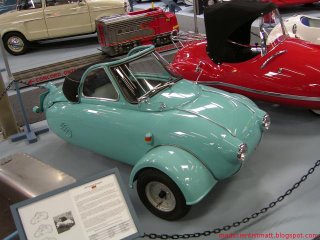Wednesday, August 09, 2006
A visit to the Microcar Museum
If you're a gearhead looking for museums in the Atlanta area, there's a very unusual one about an hour's drive away: The Bruce Weiner Microcar Museum. Founded by bubble gum millionair Bruce Weiner, this museum is dedicated to all sorts of tiny cars, particularly the little motorcycle-engined creations built in Europe immediately after World War II. Mr. Weiner's collection also includes more modern cars and some from Japan and the United States.
The cars in this museum make my Focus look big. For that matter, many of them would make a Triumph Spitfire look big. The museum's official website has many excellent photos of their cars. Rather than posting my own large gallery, I thought I'd just post a few select pictures I took on my visit.

The museum isn't particularly visible from the road; look for the Double Bubble Acres sign and turn there. I was a little surprised to see a Hummer parked outside the musuem when I arrived. Sure, may seem a little bit ironic at first glance... but living with something that large every day might be why its owner was interested in small cars.

This cute little three-wheeler is a Jurisch Motoplan.

The Isetta and the Messerschidt Kabinenroller have to be two of the most famous microcars of postwar Europe. I had to post a picture of one of them. So here's one of over a dozen Isettas. They even had a few slightly larger (just slightly) Isetta relative with seating for four, a real marvel of space efficiency.

When I left, I found that someone had parked this classic Mini outside. As you can see, it has a roll cage and probably some other race mods. Had it been inside on display, the Mini would have been one of the larger cars in there - although not the largest.
There never were very many microcars sold in the United States, but the microcar tradition lives on elsewhere. Just about every Japanese manufacturer has something to offer in the 660 cc and under kei-car segment (not to be confused with American K-cars). In Europe, DaimlerChrysler has their line of smart cars, and most other manufacturers sell cars that are smaller than the typical subcompacts sold here but usually a bit larger than the microcars in the museum. I've got to wonder, with gas prices the way they are, how many Americans would buy something like a Ford Ka or Suzuki Cappuccino?
The cars in this museum make my Focus look big. For that matter, many of them would make a Triumph Spitfire look big. The museum's official website has many excellent photos of their cars. Rather than posting my own large gallery, I thought I'd just post a few select pictures I took on my visit.

The museum isn't particularly visible from the road; look for the Double Bubble Acres sign and turn there. I was a little surprised to see a Hummer parked outside the musuem when I arrived. Sure, may seem a little bit ironic at first glance... but living with something that large every day might be why its owner was interested in small cars.

This cute little three-wheeler is a Jurisch Motoplan.

The Isetta and the Messerschidt Kabinenroller have to be two of the most famous microcars of postwar Europe. I had to post a picture of one of them. So here's one of over a dozen Isettas. They even had a few slightly larger (just slightly) Isetta relative with seating for four, a real marvel of space efficiency.

When I left, I found that someone had parked this classic Mini outside. As you can see, it has a roll cage and probably some other race mods. Had it been inside on display, the Mini would have been one of the larger cars in there - although not the largest.
There never were very many microcars sold in the United States, but the microcar tradition lives on elsewhere. Just about every Japanese manufacturer has something to offer in the 660 cc and under kei-car segment (not to be confused with American K-cars). In Europe, DaimlerChrysler has their line of smart cars, and most other manufacturers sell cars that are smaller than the typical subcompacts sold here but usually a bit larger than the microcars in the museum. I've got to wonder, with gas prices the way they are, how many Americans would buy something like a Ford Ka or Suzuki Cappuccino?
Labels: Gas Mileage

